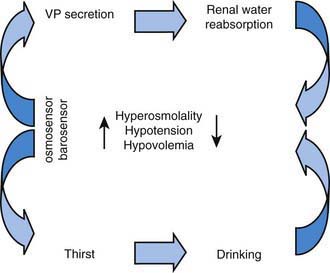Chapter 552 Diabetes Insipidus
Diabetes insipidus (DI) manifests clinically with polyuria and polydipsia and can result from either vasopressin deficiency (central DI) or vasopressin insensitivity at the level of the kidney (nephrogenic DI). Both central DI and nephrogenic DI can arise from inherited defects of congenital or neonatal onset or can be secondary to a variety of causes (Table 552-1).
Physiology of Water Balance
The control of extracellular tonicity (osmolality) and volume within a narrow range is critical for normal cellular structure and function (Chapter 52). Extracellular fluid tonicity is regulated almost exclusively by water intake and excretion, whereas extracellular volume is regulated by sodium intake and excretion. The control of plasma tonicity and intravascular volume involves a complex integration of endocrine, neural, behavioral, and paracrine systems (Fig. 552-1). Vasopressin, secreted from the posterior pituitary, is the principal regulator of tonicity, with its release largely stimulated by increases in plasma tonicity. Volume homeostasis is largely regulated by the renin-angiotensin-aldosterone system, with contributions from both vasopressin and the natriuretic peptide family.

Figure 552-1 Regulation of vasopressin (VP) secretion and serum osmolality. Hyperosmolality, hypovolemia, and hypotension are sensed by osmosensors, volume sensors, and barosensors, respectively. These stimulate both VP secretion and thirst. VP, acting on the kidney, causes increased reabsorption of water (antidiuresis). Thirst causes increased water ingestion. The results of these dual negative feedback loops cause a reduction in hyperosmolality or in hypotension or hypovolemia. Additional stimuli for VP secretion include nausea, hypoglycemia, and pain.
(From Muglia LJ, Majzoub JA: Disorders of the posterior pituitary. In Sperling MA, editor: Pediatric endocrinology, ed 2, Philadelphia, 2002, WB Saunders.)
Vasopressin, a 9-amino-acid peptide, has both antidiuretic and vascular pressor activity and is synthesized in the paraventricular and supraoptic nuclei of the hypothalamus. It is transported to the posterior pituitary via axonal projections, where it is stored awaiting release into the systemic circulation. The half-life of vasopressin in the circulation is 5 min. In addition to responding to osmotic stimuli, vasopressin is secreted in response to significant decreases in intravascular volume and pressure (minimum of 8% decrement) via afferent baroreceptor pathways arising from the aortic arch (carotid sinus) and volume receptor pathways in the cardiac atria and pulmonary veins. Osmotic and hemodynamic stimuli interact synergistically.
The sensation of thirst is regulated by cortical as well as hypothalamic neurons. The thirst threshold is approximately 10 mOsm/kg higher (i.e., 293 mOsm/kg) than the osmotic threshold for vasopressin release. Therefore, under conditions of hyperosmolality, vasopressin is released before thirst is initiated, allowing ingested water to be retained. Chemoreceptors present in the oropharynx rapidly down-regulate vasopressin release following water ingestion.
Vasopressin exerts its principal effect on the kidney via V2 receptors located primarily in the collecting tubule, the thick ascending limb of the loop of Henle, and the periglomerular tubules. The human V2 receptor gene is located on the long arm of the X chromosome (Xq28) at the locus associated with congenital, X-linked, vasopressin-resistant diabetes insipidus. Activation of the V2 receptor results in increases in intracellular cyclic adenosine monophosphate (cAMP), which leads to the insertion of the aquaporin-2 water channel into the apical (luminal) membrane. This allows water movement along its osmotic gradient into the hypertonic inner medullary interstitium from the tubule lumen and excretion of concentrated urine. In contrast to aquaporin-2, aquaporins-3 and -4 are expressed on the basolateral membrane of the collecting duct cells, and aquaporin-1 is expressed in the proximal tubule. These channels may also contribute to urinary concentrating ability.
Atrial natriuretic peptide (ANP), initially isolated from cardiac atrial muscle, has a number of important effects on salt and water balance, including stimulation of natriuresis, inhibition of sodium resorption, and inhibition of vasopressin secretion. ANP is expressed in endothelial cells and vascular smooth muscle, where it appears to regulate relaxation of arterial smooth muscle. ANP is also expressed in the brain, along with other natriuretic family members; the physiologic role of these factors has yet to be defined.

Full access? Get Clinical Tree


